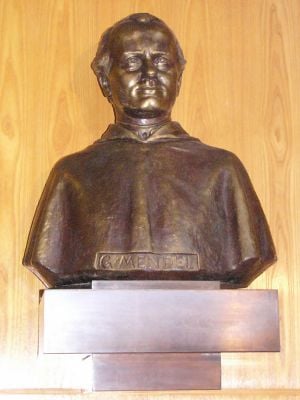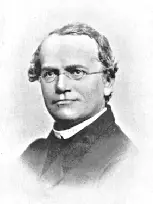Encyclopedia, Difference between revisions of "Gregor Mendel" - New World
Jim Osborn (talk | contribs) |
Rick Swarts (talk | contribs) |
||
| Line 13: | Line 13: | ||
Mendel discovered all this with no understanding of chromosomes or meiosis. Their role in heredity years after Mendel’s death showed how Mendel’s laws are carried out. | Mendel discovered all this with no understanding of chromosomes or meiosis. Their role in heredity years after Mendel’s death showed how Mendel’s laws are carried out. | ||
| + | |||
| + | [[Image:StThomasAbbeyBrno.jpg|left|thumb|The Augustinian Abbey of St Thomas, Brno.]] | ||
Mendel's attraction to research was based on his love of nature. He was not only interested in plants, but also in meteorology and theories of evolution. Mendel often wondered how plants obtained atypical characteristics. On one of his frequent walks around the monastery, he found an atypical variety of an ornamental plant. He took it and planted it next to the typical variety. He grew their progeny side by side to see if there would be any approximation of the traits passed on to the next generation. This experiment was "designed to support or to illustrate [[Jean-Baptiste Lamarck|Lamarck]]'s views concerning the influence of environment upon plants." He found that the plants' respective offspring retained the essential traits of the parents, and therefore were not influenced by the environment. This simple test gave birth to the idea of heredity. | Mendel's attraction to research was based on his love of nature. He was not only interested in plants, but also in meteorology and theories of evolution. Mendel often wondered how plants obtained atypical characteristics. On one of his frequent walks around the monastery, he found an atypical variety of an ornamental plant. He took it and planted it next to the typical variety. He grew their progeny side by side to see if there would be any approximation of the traits passed on to the next generation. This experiment was "designed to support or to illustrate [[Jean-Baptiste Lamarck|Lamarck]]'s views concerning the influence of environment upon plants." He found that the plants' respective offspring retained the essential traits of the parents, and therefore were not influenced by the environment. This simple test gave birth to the idea of heredity. | ||
| Line 46: | Line 48: | ||
* James Walsh, ''Catholic Churchmen in Science'', Philadelphia: Dolphin Press, 1906 | * James Walsh, ''Catholic Churchmen in Science'', Philadelphia: Dolphin Press, 1906 | ||
* [[Bartel Leendert van der Waerden]] ''Mendel's experiments'' Centaurus 12, 275-288 (1968) refutes allegations about "data smoothing" | * [[Bartel Leendert van der Waerden]] ''Mendel's experiments'' Centaurus 12, 275-288 (1968) refutes allegations about "data smoothing" | ||
| − | |||
| − | |||
| − | |||
| − | |||
| − | |||
| − | |||
| − | |||
| − | |||
| − | |||
| − | |||
| − | |||
| − | |||
| − | |||
| − | |||
| − | |||
{{credit|34502607}} | {{credit|34502607}} | ||
[[Category:Life sciences]] | [[Category:Life sciences]] | ||
Revision as of 16:22, 19 February 2006
Gregor Johann Mendel (July 20[1], 1822 – January 6, 1884) was an Austrian monk who is often called the "father of genetics" for his study of the inheritance of traits in pea plants. Mendel showed that there was particulate inheritance of traits according to his laws of inheritance. The significance of Mendel's work was not recognized until the turn of the 20th century. Its rediscovery prompted the foundation of genetics.
Biography
Mendel was born into a German-speaking family of Heinzendorf, Moravia, Austrian Empire (now Hynčice (part of Vražné), district of Nový Jičín, Czech Republic). During his childhood Mendel worked as a gardener, and as a young man attended the Philosophical Institute in Olomouc. In 1843 he entered the Augustinian Abbey of St. Thomas in Brno. Born Johann Mendel, he took the name Gregor upon entering monastic life. In 1847 he was ordained as a priest. In 1851 he was sent to the University of Vienna to study, returning to his abbey in 1853 as a teacher, principally of physics. [2]
Gregor Mendel was inspired by both his professors at university and his colleagues at the monastery to study variation in plants. He commenced his study in his monastery's experimental garden. Between 1856 and 1863 Mendel cultivated and tested some 28,000 pea plants.
Mendel had discovered that many characteristics of peas had an either-or configuration; for example, pea plants were either tall (as high as six feet) or dwarf (no more than 20 inches high), seeds green or yellow, seeds round or “wrinkled”, with no blending when to variations were crossed. Moreover, he found that he could create pea seeds that “breed true,” that is, seeds that always produced tall vines, and the next generation of seeds from these plants also produced only tall vines. But if plants that bred true for tall were crossed with plants that bred true for dwarf, all the seeds produced tall plants. But when these next-generation seeds were planted, the dwarf plants reappeared, and the ratio of tall plants to dwarf plants was close to 3:1. These results show that genes do not blend but behave as discreet units. In addition, if more than one trait is studied (for example, plant height and seed color), these traits independently assort and are expressed independently of each other.
Mendel discovered all this with no understanding of chromosomes or meiosis. Their role in heredity years after Mendel’s death showed how Mendel’s laws are carried out.
Mendel's attraction to research was based on his love of nature. He was not only interested in plants, but also in meteorology and theories of evolution. Mendel often wondered how plants obtained atypical characteristics. On one of his frequent walks around the monastery, he found an atypical variety of an ornamental plant. He took it and planted it next to the typical variety. He grew their progeny side by side to see if there would be any approximation of the traits passed on to the next generation. This experiment was "designed to support or to illustrate Lamarck's views concerning the influence of environment upon plants." He found that the plants' respective offspring retained the essential traits of the parents, and therefore were not influenced by the environment. This simple test gave birth to the idea of heredity.
Mendel read his paper, Experiments on Plant Hybridization, at two meetings of the Natural History Society of Brunn in Bohemia in 1865. When Mendel's paper was published in 1866 in Proceedings of the Natural History Society of Brunn (Brno), Mendel requested 40 reprints from the journal editor and mailed at least a dozen of them out to respected scientists throughout Europe, even to Charles Darwin; yet it had little impact, and was cited about three times over the next thirty-five years.
Elevated as abbot in 1868, his scientific work largely ended as Mendel became consumed with his increased administrative responsibilities, especially a dispute with the civil government over their attempt to impose special taxes on religious institutions. [3]
Mendel died on January 6, 1884 in Brno, Austria-Hungary (now Czech Republic), from chronic nephritis.
Rediscovery of Mendel's work
It was not until the early 20th century that the importance of his ideas was realized. In 1900, his work was finally rediscovered by Hugo de Vries, Carl Correns and Erich von Tschermak. His results were quickly replicated, and genetic linkage quickly worked out. However, a period of tense argument ensued over its significance between William Bateson and Karl Pearson. Ronald Fisher in 1918 used Mendelian genetics as the basis of the start of the modern synthesis in evolutionary biology.
His experimental results have later been the object of considerable dispute. The renowned statistician Ronald Fisher analyzed the results of the F1 (first filial) ratio and found them to be implausibly close to the exact ratio of 3 to 1. Only a few would accuse Mendel of scientific malpractice or call it a scientific fraud — reproduction of his experiments has demonstrated the accuracy of his hypothesis — however, the results have continued to be a mystery for many, though it is often cited as an example of confirmation bias, and he is generally suspected of having "smoothed" his data to some degree (not knowing about the importance of blind classification). The fact that his reported results concentrate on the few traits in peas which are determined by a single gene has also suggested that he may have censored his results, otherwise he would have stumbled across genetic linkage.
The standard botanical author abbreviation Mendel is applied to species he described..
Mendel, Darwin and Galton

Mendel lived around the same time as the British naturalist Charles Darwin (1809 – 1882), and many have fantasized about a historical evolutionary synthesis of Darwinian natural selection and Mendelian genetics during their lifetimes. Mendel had read a German translation of Darwin's Origin (as evidenced by underlined passages in the copy in his monastery), after completing his experiments but before publishing his paper. Some passages in Mendel's paper are Darwinian in character, evidence that the Origin of the Species influenced Mendel's writing. Darwin apparently received a copy of Mendel's paper, but there is no evidence he read it; he also had a book by Focke with references to it. The leading expert in heredity at this time was Darwin's cousin Francis Galton who had mathematical skills that Darwin lacked and may have been able to understand the paper had he seen it. In any event, the modern evolutionary synthesis did not start until the 1920s, by which time statistics had become advanced enough to cope with genetics and evolution.
Notes
- ^ July 20 is his birthday, often mentioned July 22 is date of his baptism.
Bibliography
- Colin Tudge In Mendel's footnotes ISBN 0099288753 book about Gregor Mendel
- Curt Stern and Sherwood ER (1966) The Origin of Genetics.
- Robin Marantz Henig, Monk in the Garden: The Lost and Found Genius of Gregor Mendel, the Father of Genetics, Houghton Mifflin, May, 2000, hardcover, 292 pages, ISBN 0395977657; trade paperback, Houghton Mifflin, May, 2001, ISBN 0618127410
- William Bateson Mendel's Principles of Heredity, a Defense, First Edition, London: Cambridge University Press, 1902. On-line Facsimile Edition: Electronic Scholarly Publishing, Prepared by Robert Robbins
- Reginald Punnett, Mendelism, Cambridge, 1905
- Robert Lock, Recent Progress in the Study of Variation, Heredity and Evolution, London, 1906
- James Walsh, Catholic Churchmen in Science, Philadelphia: Dolphin Press, 1906
- Bartel Leendert van der Waerden Mendel's experiments Centaurus 12, 275-288 (1968) refutes allegations about "data smoothing"
Credits
New World Encyclopedia writers and editors rewrote and completed the Wikipedia article in accordance with New World Encyclopedia standards. This article abides by terms of the Creative Commons CC-by-sa 3.0 License (CC-by-sa), which may be used and disseminated with proper attribution. Credit is due under the terms of this license that can reference both the New World Encyclopedia contributors and the selfless volunteer contributors of the Wikimedia Foundation. To cite this article click here for a list of acceptable citing formats.The history of earlier contributions by wikipedians is accessible to researchers here:
The history of this article since it was imported to New World Encyclopedia:
Note: Some restrictions may apply to use of individual images which are separately licensed.


